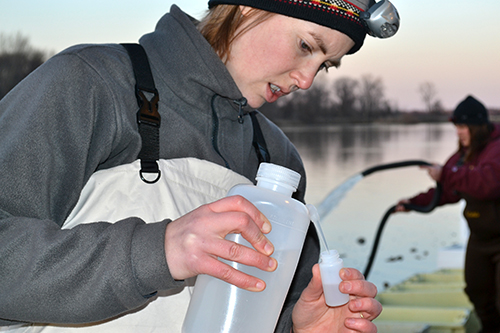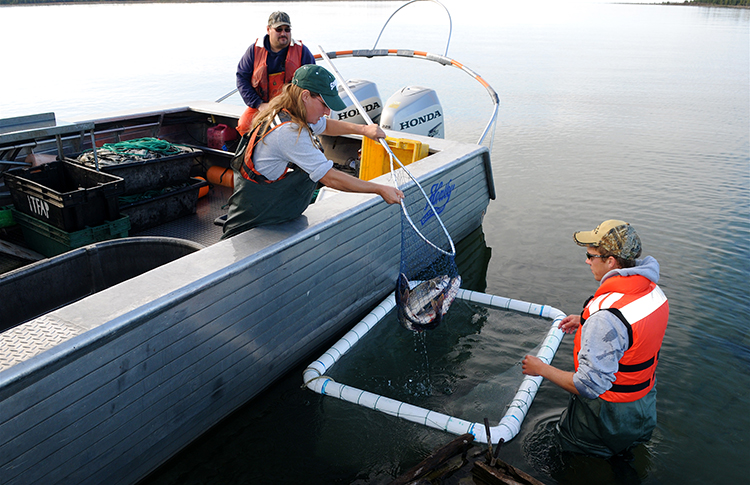Great Lakes Fishery Commission Research: Science to Inform Management
Managing and sustaining the Great Lakes fishery depends on understanding the natural and human-induced factors that affect the lakes. Since 1956, the Great Lakes Fishery Commission has been a leader in promoting and facilitating Great Lakes science and its use in fishery management decision making. The commission coordinates, conducts, and communicates science.
The commission's science program is authorized under the Convention on Great Lakes Fisheries, established in 1954 between Canada and the United States. The commission funds research conducted by scientific and technical personnel in universities, private consulting firms, and federal, provincial, state, and tribal agencies. Communication of research findings (i.e. science transfer) involves sponsoring symposia, publishing research in various media, and making recommendations to government.
What does the commission's science program mean to the Great Lakes?
The program helps the commission:
- control sea lamprey effectively;
- demonstrate that fish populations are interconnected, that they are vulnerable to human-induced and natural changes, and that restoring native species—particularly predatory fish—will bring a more natural balance to the ecosystem;
- highlight that certain invasive species, over-fishing or over-harvest, and habitat destruction act to destabilize aquatic communities and the fisheries they support; and
- recommend measures to sustain and improve the valuable fishery.
To help sustain and improve Great Lakes fishery management, the commission actively supports the transfer of science to those who will put it to use.
The future vision for science

Information about interactions among species and their responses in a changing environment is needed if managers are to anticipate and respond to changes. Therefore, important areas of commission research will focus on large-scale disturbances such as invasive species and climate change and on how they influence fish communities; causes for rapid ecological change in Lakes Huron, Michigan, and Ontario; and impediments to re-establish native fishes and their fisheries. The study of other large-lake systems will be a key strategy to advance an understanding of Great Lakes ecosystems. The challenge in using new information to achieve healthy Great Lakes ecosystems is large and will require coordination and cooperation among many federal, provincial, state, and tribal agencies and non-governmental partners.
The Great Lakes Fishery Commission's science program is organized into external (competitive) research and internal (directed) research:
Competitive Research Programs
Fishery Research is essential to achievement of a healthy Great Lakes ecosystem. Many projects support the research priorities set by the lake committees of fishery managers.
Sea Lamprey Research is important to the control program, including investigations into the sea lamprey's genome, pheromones and repellents, and development of innovative control techniques.
The commission considers funding for research projects based on peer reviews of proposals and advice from boards, comprising experts from academia and provincial, state, tribal, and federal governments, and tribes.
Check out the Funding for Research page for more information on how to apply, types of funding offered, and the annual funding cycle.
Directed Research Programs
The Science Transfer Program promotes uptake of science to fishery managers and sea lamprey control agents.
The Partnership in Ecosystem Research and Management (PERM) supports three faculty research scientists at Michigan State University’s Department of Fisheries and Wildlife (MSU-FW) and one scientist in the Department of Integrative Biology at the University of Guelph, Ontario. The original PERM agreement was signed in 1997 between the commission and MSU-FW and was expanded to Guelph in 2001. PERM scientists have worked extensively with the commission’s science program, particularly in the area of sea lamprey research, focusing on sea lamprey chemoreception, movement ecology and behavior, population dynamics, and assessment.
Partnerships with the U.S. Geological Survey (USGS) provide science and regulatory support to the commission. The Hammond Bay Biological Station (HBBS) is a field station of the USGS Great Lakes Science Center that is jointly managed and operated via a collaborative agreement between the commission and USGS. Scientists at HBBS conduct research and provide technical support to the commission and its sea lamprey control agents: the U.S. Fish and Wildlife Service and Fisheries and Oceans Canada. The USGS Upper Midwest Environmental Sciences center also provides technical assistance, regulatory affairs support, and emerging technology research for the commission and its sea lamprey control agents via a collaborative agreement.


